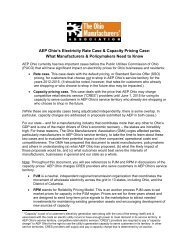2012 Ohio Election Guide - Gripelements.com
2012 Ohio Election Guide - Gripelements.com
2012 Ohio Election Guide - Gripelements.com
Create successful ePaper yourself
Turn your PDF publications into a flip-book with our unique Google optimized e-Paper software.
METHODOLOGY DEMOGRAPHICSMethodology Used to Produce 2010 Census SummaryFile 1 (SF1) and 2006-2010 Census American CommunitySurvey (ACS)Estimates for U.S. Congressional and <strong>Ohio</strong> House and Senate Districts.June 1, <strong>2012</strong>(displayed on pages 192–197)Though the Census Bureau’s 2010 Summary File 1 (SF1) data and the 2006–2010 AmericanCommunity Survey (ACS) 1 provide relatively recent demographic and socioeconomic data, thosedata are not currently available for the <strong>2012</strong> U.S. Congressional and <strong>Ohio</strong>’s General Assemblydistricts. Therefore the Northern <strong>Ohio</strong> Data & Information Service (NODIS) estimated data for thedistricts based on aggregating census block and block group level data, and apportioning blockand block group level data for cases in which the block or block group is shared by more than onedistrict.The following notes provide more detail.1. The 2010 SF1 data were aggregated to the district levels. This provides the basic demographicsof households, population, race, age and gender. If a block was geographically divided bymore than one district the characteristics of the block were allocated to districts based onproportions from the equivalency files.2. The ACS data provides other demographic and socioeconomic data, such as in<strong>com</strong>e andeducational attainment data. The ACS Summary Files were used for estimating these data fordistricts. The data were aggregated using a <strong>com</strong>bination of whole counties, <strong>com</strong>munities, andcensus tract or block group data when such geographic units were wholly contained withina district and applying the block/split block proportions when such units are shared by morethan one district.3. ACS data are based on a sample. Using larger geographic levels when aggregatingsample data provides lower margins of error. Margins of error were calculated using themethodologies provided by the Census Bureau. 24. Since the ACS data we provide are estimated using portions of Census Bureau geographies,our estimates will differ slightly from data to be provided later by the Census Bureau.1 Census ACS 2006–2010 provides relatively recent estimates, but the sample size is much smaller than the long form 2000SF3 sample. The 5 years of ACS data provide a sample that is only about one half the size of the 2000 SF3 sample; thusestimates are subject to wider confidence intervals.2The margins of error were calculated using the "American Community Survey Multiyear Accuracy of the Data” availableat http://www.census.gov/acs/www/Downloads/data_documentation/Accuracy/MultiyearACSAccuracyofData2010.pdf.The medians were calculated using a modified version of the Public Use Micro Data’s median margin of error.190 — THE OHIO MANUFACTURERS’ ASSOCIATION





